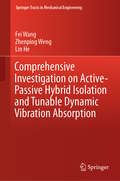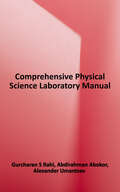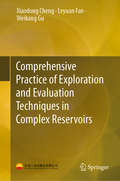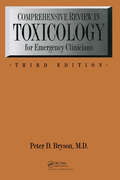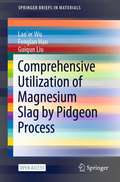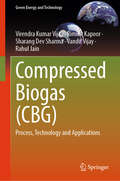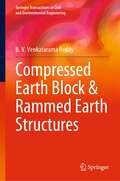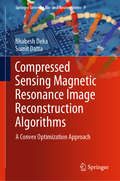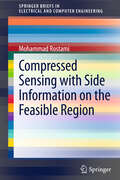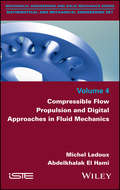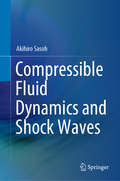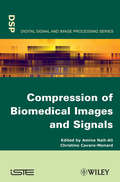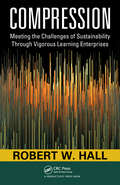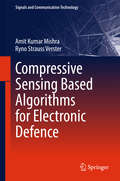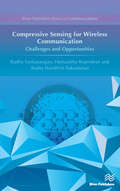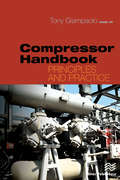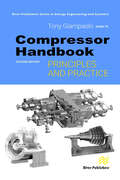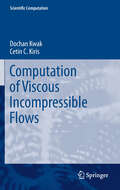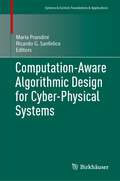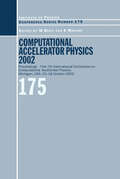- Table View
- List View
Comprehensive Investigation on Active-Passive Hybrid Isolation and Tunable Dynamic Vibration Absorption (Springer Tracts in Mechanical Engineering)
by Lin He Fei Wang Zhenping WengThis book discusses efforts to control the low-frequency vibration transmission of typical power equipment and pipeline systems of ships, exploring the use of active and passive hybrid vibration isolation and adjustable dynamic vibration absorption technologies. It also proposes an adaptive feed-forward control strategy and studies a distributed feed-forward control hardware system. In addition, the book presents a three-way dynamic vibration absorption theory used to design a pipeline-system adjustable dynamic vibration absorber, which offers a number of advantages, such as compact structure, easy assembly and disassembly, low power consumption, excellent vibration control effect and wide frequency band adjustable ability, etc. This book is a valuable resource for researchers and engineers in the fields of noise and vibration control, active control systems, active vibration isolation and adaptive dynamic vibration absorption.
Comprehensive Physical Science Laboratory Manual
by Alexander Umantsev Gurcharan S Rahi Abdirahman AbokorThis is a laboratory manual for a one-semester college physical science course. This manual aims to familiarize students with some of the fundamental concepts of physical science by providing the opportunity to experimentally test the theories and hypotheses of physics and chemistry discussed in the lectures. Conducting experiments and collecting data to test the validity of theories and laws requires a different set of skills than those required for success in lecture. The work done in the laboratory will augment the student’s understanding of the lecture material as well as provide them with the opportunity to become familiar with the basic experimental techniques. Laboratory sessions described by the guide are designed to provide a hands-on introduction to experimental methods of scientific investigation. Each one provides the practical knowledge necessary for a well-rounded understanding of physical science.
Comprehensive Practice of Exploration and Evaluation Techniques in Complex Reservoirs
by Xiaodong Cheng Leyuan Fan Weikang GuThis book covers exploration and evaluation practices for various types of complex reservoirs, and summarizes a series of practical and effective techniques and methods.For example, it shows how, by integrating multiple types of new logging technology, complex reservoir petrophysics evaluation can be performed using high-precision core experiment data and quantitative logging interpretation; and demonstrates how the technology of sporopollen assemblage and palynofacies analysis can improve the time precision of sequence stratigraphy and the quantitative study level of sedimentary facies, respectively. It discusses how reservoir lateral prediction and vertical resolution can be substantially improved by integrating fracture prediction and geostatistical inversion; and presents innovative log interpretation charts for the lithological identification of metamorphic rocks, e.g. GR-DEN crossplot and Impedance-Resistivity crossplot.To support the main content, the book features a wealth of high-resolution, thin- section images, quantitative illustrations of palynofacies composition, multi-property overlapping map set and quantitative tables. It offers an essential reference guide for researchers in geological exploration and evaluation, and will also appeal to a broad readership, from engineering technicians to advanced graduate students in related areas.
Comprehensive Quality by Design for Pharmaceutical Product Development and Manufacture
by Christine Seymour Salvador García-Munoz Gintaras V. ReklaitisCovers a widespread view of Quality by Design (QbD) encompassing the many stages involved in the development of a new drug product. The book provides a broad view of Quality by Design (QbD) and shows how QbD concepts and analysis facilitate the development and manufacture of high quality products. QbD is seen as a framework for building process understanding, for implementing robust and effective manufacturing processes and provides the underpinnings for a science-based regulation of the pharmaceutical industry. Edited by the three renowned researchers in the field, Comprehensive Quality by Design for Pharmaceutical Product Development and Manufacture guides pharmaceutical engineers and scientists involved in product and process development, as well as teachers, on how to utilize QbD practices and applications effectively while complying with government regulations. The material is divided into three main sections: the first six chapters address the role of key technologies, including process modeling, process analytical technology, automated process control and statistical methodology in supporting QbD and establishing the associated design space. The second section consisting of seven chapters present a range of thoroughly developed case studies in which the tools and methodologies discussed in the first section are used to support specific drug substance and drug-product QbD related developments. The last section discussed the needs for integrated tools and reviews the status of information technology tools available for systematic data and knowledge management to support QbD and related activities. Comprehensive Quality by Design for Pharmaceutical Product Development and Manufacture is an ideal book for practitioners, researchers, and graduate students involved in the development, research, or studying of a new drug and its associated manufacturing process.
Comprehensive Reviews in Toxicology: For Emergency Clinicians
by Peter D BrysonRevised and updated, this edition covers general principles of overdose management; the automonic nervous system, neurotransmitters and drugs; drugs used in psychiatry; cardiac drugs; agents that burn; gases and abnormal haemoglobin formation; the
Comprehensive Utilization of Magnesium Slag by Pidgeon Process (SpringerBriefs in Materials)
by Fenglan Han Lan'er Wu Guiqun LiuThis open access book introduces the harmless handling/recycling of magnesium slag , the process of magnesium silicothermic reduction (Pidgeon process)which the slag was produced, and . the magnesium resources, layout of the industry of the world. Examples and experimental data in this book are from the author group’s research programs, as well as the rencent researches in China. The book could provide precious reference to scientists and engineers in the field of recycling and environment friendly use of the industrial solid wastes. It could also be used for researchers and students who are interested in relevant field.
Compressed Biogas: Process, Technology and Applications (Green Energy and Technology)
by Rahul Jain Virendra Kumar Vijay Rimika Kapoor Sharang Dev Sharma Vandit VijayThis book provides theoretical and practical information on biogas production and upgradation (CBG) in a lucid manner and real-life scenarios. The core topics covered include: (i) introduction to biogas production, cleaning and up-gradation and specifications of biomethane in various countries for different applications; (ii) description of various processes and technologies for the cleaning of biogas; (iii) a detailed information on the technologies for separation of carbon dioxide from biogas to upgrade it to biomethane (CBG), (iv) assessment and comparison of the biogas up-gradation technologies on the basis of various techno-economic factors, (v) design and development of water scrubbing technology and (vi) future prospects of decentralized biogas up-gradation and bottling technology. CBG is a growing field for mitigating climate change, waste management, and disposal. This book provides information on how the biogas up-gradation sector is developing and how it could harness its potential in a decentralised manner. A broad description of technological innovations and developments in the sector has been provided. This book will be of use to students, researchers, professionals, entrepreneurs, municipalities, nodal agencies of state and central governments, CBG Plant owners & operators, etc. It can also be used as a text for professional training, skill development and capacity building for stakeholders.
Compressed Earth Block & Rammed Earth Structures (Springer Transactions in Civil and Environmental Engineering)
by B. V. ReddyThe book focuses on low carbon construction materials such as stabilised compressed earth blocks (CEB’s) and rammed earth (RE). The content has been divided into four broad themes which includes an introduction to earth construction & stabilised earth, stabilised compressed earth blocks and masonry, stabilised rammed earth, and energy, carbon emissions, sustainability and case studies. It provides basic introduction to earthen materials and earthen structures, particularly with reference to the contemporary work on stabilised earth products for structural applications in buildings. The illustrations in the form of graphs, tables and photographs help the reader to get a grip over the CEB and RE construction. The book illustrates many case studies and examples of CEB and RE buildings. The knowledge on structural characteristics of CEB and RE especially with reference to the durability of such earthen products, and the structural design aspects is uniquely dealt. The embodied energy, embodied carbon, and the impact on construction sector touching upon sustainability of buildings is another unique feature of the book. This volume will be a useful guide for the research community, teachers, engineers, architects, building professionals, practicing engineers, students and individuals aspiring to build low carbon and sustainable buildings.
Compressed Sensing Magnetic Resonance Image Reconstruction Algorithms: A Convex Optimization Approach (Springer Series on Bio- and Neurosystems #9)
by Bhabesh Deka Sumit DattaThis book presents a comprehensive review of the recent developments in fast L1-norm regularization-based compressed sensing (CS) magnetic resonance image reconstruction algorithms. Compressed sensing magnetic resonance imaging (CS-MRI) is able to reduce the scan time of MRI considerably as it is possible to reconstruct MR images from only a few measurements in the k-space; far below the requirements of the Nyquist sampling rate. L1-norm-based regularization problems can be solved efficiently using the state-of-the-art convex optimization techniques, which in general outperform the greedy techniques in terms of quality of reconstructions. Recently, fast convex optimization based reconstruction algorithms have been developed which are also able to achieve the benchmarks for the use of CS-MRI in clinical practice. This book enables graduate students, researchers, and medical practitioners working in the field of medical image processing, particularly in MRI to understand the need for the CS in MRI, and thereby how it could revolutionize the soft tissue imaging to benefit healthcare technology without making major changes in the existing scanner hardware. It would be particularly useful for researchers who have just entered into the exciting field of CS-MRI and would like to quickly go through the developments to date without diving into the detailed mathematical analysis. Finally, it also discusses recent trends and future research directions for implementation of CS-MRI in clinical practice, particularly in Bio- and Neuro-informatics applications.
Compressed Sensing with Side Information on the Feasible Region (SpringerBriefs in Electrical and Computer Engineering)
by Mohammad RostamiThis book discusses compressive sensing in the presence of side information. Compressive sensing is an emerging technique for efficiently acquiring and reconstructing a signal. Interesting instances of Compressive Sensing (CS) can occur when, apart from sparsity, side information is available about the source signals. The side information can be about the source structure, distribution, etc. Such cases can be viewed as extensions of the classical CS. In these cases we are interested in incorporating the side information to either improve the quality of the source reconstruction or decrease the number of samples required for accurate reconstruction. In this book we assume availability of side information about the feasible region. The main applications investigated are image deblurring for optical imaging, 3D surface reconstruction, and reconstructing spatiotemporally correlated sources. The author shows that the side information can be used to improve the quality of the reconstruction compared to the classic compressive sensing. The book will be of interest to all researchers working on compressive sensing, inverse problems, and image processing.
Compressible Flow Propulsion and Digital Approaches in Fluid Mechanics
by Abdelkhalak El Hami Michel LedouxThis book aims to provide an efficient methodology of solving a fluid mechanics problem, based on an awareness of the physical. It meets different objectives of the student, the future engineer or scientist: Simple sizing calculations are required to master today′s numerical approach for solving complex practical problems.
Compressible Flow with Applications to Engines, Shocks and Nozzles (Mathematics and Physics for Science and Technology #11)
by Luis Manuel Braga da Costa Campos Luís António Raio VilelaCompressible Flow with Application to Shocks and Propulsion is part of the series "Mathematics and Physics for Science and Technology", which combines rigorous mathematics with general physical principles to model practical engineering systems with a detailed derivation and interpretation of results. Volume V presents the mathematical theory of partial differential equations and methods of solution satisfying initial and boundary conditions, and includes applications to: acoustic, elastic, water, electromagnetic and other waves; the diffusion of heat, mass and electricity; and their interactions. This is the second book of the volume. The first book of volume V starts with the classification of partial differential equations and proceeds with similarity methods that apply in general to linear equations with constant coefficients and all derivatives of the same order, such as the Laplace and Biharmonic equations, without and with forcing. The similarity solutions are also applied to Burger's non-linear diffusion equation. First-order linear and quasi-linear partial differential equations with variable coefficients are considered, with application to the representation of conservative/non-conservative, solenoidal/rotational and Beltrami/helical vector fields by one, two or three scalar and/or one vector potential in relation with exact, inexact and non-integrable differentials. The latter appear in the first and second principles of thermodynamics that specify the constitutive and diffusive properties of matter as concerns thermal, mechanical, elastic, flow, electrical, magnetic and chemical phenomena and their interactions. The book is intended for graduate students and engineers working with mathematical models and can be applied to problems in mechanical, aerospace, electrical and other branches of engineering dealing with advanced technology, and also in the physical sciences and applied mathematics. This book: Simultaneously covers rigorous mathematics, general physical principles and engineering applications with practical interest Provides interpretation of results with the help of illustrations Includes detailed proofs of all results L.M.B.C. Campos was chair professor and the Coordinator of the Scientific Area of Applied and Aerospace Mechanics in the Department of Mechanical Engineering and also the director (and founder) of the Center for Aeronautical and Space Science and Technology until retirement in 2020. L.A.R. Vilela is currently completing an Integrated Master's degree in Aerospace Engineering at Institute Superior Tecnico (1ST) of Lisbon University.
Compressible Flow: A Straightforward Approach with Practical Applications Including Pipeline Flow
by Nuggenhalli S. NandagopalThis book focuses on the foundations of compressible flow, illustrating the use of principles of thermodynamics and fluid dynamics in the development of compressible flow equations. It presents the topics in an organized manner facilitating natural, logical flow of the subject matter. All the relevant equations are derived rigorously using basic mathematics and mass, momentum, and energy conservation principles; that is, continuity, momentum and energy equations. The applications of compressible flow equations are illustrated using numerous example and practice problems. The topics covered include Mach number, isentropic flow, stagnation-static relationships, compressible flow tables for air, compressible flow measurements, Pitot Tube, Pitot Static Tube, Rayleigh-Pitot Equation, compressible flow with area changes, sonic flow, sonic area, sonic relationships, shock waves, shock wave relationships, normal shock waves in nozzles, moving shock waves with applications to sudden opening and closing of valves, oblique shock waves and Prandtl-Meyer expansion waves, compressible flow through ducts and pipes, adiabatic compressible flow with friction loss, Fanno Flow, compressible flow with heat transfer, Rayleigh Flow, and isothermal compressible flow through pipelines. A unique feature of this book is that it presents novel methods to solve compressible flow problems through extensive use of spreadsheets. The spreadsheet-based solution methods presented in this book eliminates the need for cumbersome trial and error procedures and they can be used in solving a great variety of problems just by suitably changing the required inputs. This book also presents a ground-breaking, rigorous approach to solving gas flow problems in pipelines through the use of appropriate generalized compressibility factors and friction factors, dispelling the wide range of results that one can possibly obtain from approaches such as Weymouth and Panhandle equations. Includes 85+ Illustrative example problems and 40+ practice problems, both with detailed solutions (in both S I and US Customary units) Presents rigorous derivations of all relevant equations using fundamental mathematics and relevant physical principles Explains concepts in an accessible and thorough manner with practical applications that readers can easily understand Extensive use of spreadsheets in solving compressible flow problems
Compressible Fluid Dynamics and Shock Waves
by Akihiro SasohThis book offers comprehensive coverage of compressible flow phenomena and their applications, and is intended for undergraduate/graduate students, practicing professionals, and researchers interested in the topic. Thanks to the clear explanations provided of a wide range of basic principles, the equations and formulas presented here can be understood with only a basic grasp of mathematics.The book particularly focuses on shock waves, offering a unique approach to the derivation of shock wave relations from conservation relations in fluids together with a contact surface, slip line or surface; in addition, the thrust of a rocket engine and that of an air-breathing engine are also formulated. Furthermore, the book covers important fundamentals of various aspects of physical fluid dynamics and engineering, including one-dimensional unsteady flows, and two-dimensional flows, in which oblique shock waves and Prandtl-Meyer expansion can be observed.
Compression of Biomedical Images and Signals
by Amine Nait-Ali Christine Cavaro-MenardDuring the last decade, image and signal compression for storage and transmission purpose has seen a great expansion. But what about medical data compression? Should a medical image or a physiological signal be processed and compressed like any other data? The progress made in imaging systems, storing systems and telemedicine makes compression in this field particularly interesting. However, this compression has to be adapted to the specificities of biomedical data which contain diagnosis information. As such, this book offers an overview of compression techniques applied to medical data, including: physiological signals, MRI, X-ray, ultrasound images, static and dynamic volumetric images. Researchers, clinicians, engineers and professionals in this area, along with postgraduate students in the signal and image processing field, will find this book to be of great interest.
Compression: Meeting the Challenges of Sustainability Through Vigorous Learning Enterprises
by Robert W. HallCOMPRESSION: Meeting the Challenges of Sustainability Through Vigorous Learning Enterprises sounds a clarion that we cannot afford to ignore. Global crises are squeezing us from all directions. Mostly they have to do with not enough: not enough natural resources to maintain our standard of living, not enough carbon rich soil to grow crops enough to
Compressive Sensing Based Algorithms for Electronic Defence (Signals and Communication Technology)
by Amit Kumar Mishra Ryno Strauss VersterThis book details some of the major developments in the implementation of compressive sensing in radio applications for electronic defense and warfare communication use. It provides a comprehensive background to the subject and at the same time describes some novel algorithms. It also investigates application value and performance-related parameters of compressive sensing in scenarios such as direction finding, spectrum monitoring, detection, and classification.
Compressive Sensing for Wireless Communication: Challenges and Opportunities (River Publishers Series In Communications Ser.)
by Radha Sankararajan Hemalatha Rajendran Aasha Nandhini SukumaranCompressed Sensing (CS) is a promising method that recovers the sparse and compressible signals from severely under-sampled measurements. CS can be applied to wireless communication to enhance its capabilities. As this technology is proliferating, it is possible to explore its need and benefits for emerging applicationsCompressive Sensing for Wireless Communication provides:• A clear insight into the basics of compressed sensing• A thorough exploration of applying CS to audio, image and computer vision• Different dimensions of applying CS in Cognitive radio networks• CS in wireless sensor network for spatial compression and projection• Real world problems/projects that can be implemented and tested• Efficient methods to sample and reconstruct the images in resource constrained WMSN environmentThis book provides the details of CS and its associated applications in a thorough manner. It lays a direction for students and new engineers and prepares them for developing new tasks within the field of CS. It is an indispensable companion for practicing engineers who wish to learn about the emerging areas of interest.
Compressor Handbook: Principles and Practice
by Anthony GiampaoloThis book provides a practical introduction to dynamic and positive displacement compressors, including compressor performance, operation, and problem awareness. In reading this book readers will learn what is needed to select, operate, and troubleshoot compressors. Complete with real-life case histories, the book demonstrates investigative techniques for identifying and isolating various contributing causes, including design deficiencies, manufacturing defects, adverse environmental conditions, operating errors, and intentional or unintentional changes of the machinery process that usually precede failure.
Compressor Handbook: Principles and Practice
by Tony GiampaoloThis book examines the full spectrum of compressor types, how they operate, how to control them, and how operating conditions can significantly impact their performance. Discussed in detail are the influence of pressure, temperature, molecular weight, specific heat ratio, compression ratio, speed, vane position, and volume bottles. The various methods of throughput control are also addressed, including discharge throttling, suction throttling, guide pain positioning, volume, bottles, suction valve unloaders, speed control, as well as how each of these control methods affects compressor life. Compressor surge is defined and discussed in detail, along with the types of instrumentation (controllers, valves, pressure, and temperature transmitters) available, and which of those are most suitable for controlling search. Case studies have been included to illustrate the principles covered in the text. This edition also includes detailed information on compressor seals. Various types of seals providing the best results for different applications are discussed, thereby giving the reader a basic understanding of seals serotypes and applications.
Compromising the Ideals of Science
by Raphael SassowerThis books examines the conditions under which scientists compromised the ideals of science, and elucidates these with reference to the challenges of profit motives and national security concerns. The book also offers suggestions for changing the political and economic conditions under which the integrity of science and its ethos can be practiced.
Computation of Viscous Incompressible Flows (Scientific Computation)
by Cetin C. Kiris Dochan KwakThis monograph is intended as a concise and self-contained guide to practitioners and graduate students for applying approaches in computational fluid dynamics (CFD) to real-world problems that require a quantification of viscous incompressible flows. In various projects related to NASA missions, the authors have gained CFD expertise over many years by developing and utilizing tools especially related to viscous incompressible flows. They are looking at CFD from an engineering perspective, which is especially useful when working on real-world applications. From that point of view, CFD requires two major elements, namely methods/algorithm and engineering/physical modeling. As for the methods, CFD research has been performed with great successes. In terms of modeling/simulation, mission applications require a deeper understanding of CFD and flow physics, which has only been debated in technical conferences and to a limited scope. This monograph fills the gap by offering in-depth examples for students and engineers to get useful information on CFD for their activities. The procedural details are given with respect to particular tasks from the authors' field of research, for example simulations of liquid propellant rocket engine subsystems, turbo-pumps and the blood circulations in the human brain as well as the design of artificial heart devices. However, those examples serve as illustrations of computational and physical challenges relevant to many other fields. Unlike other books on incompressible flow simulations, no abstract mathematics are used in this book. Assuming some basic CFD knowledge, readers can easily transfer the insights gained from specific CFD applications in engineering to their area of interest.
Computation-Aware Algorithmic Design for Cyber-Physical Systems (Systems & Control: Foundations & Applications)
by Ricardo G. Sanfelice Maria PrandiniThis contributed volume aims to build the foundation of a framework for computationally aware algorithmic design for cyber-physical systems (CPSs), focusing on approaches that take computation into account at the design stage to address their impact on performance and safety. It demonstrates how novel techniques may emerge from the combination of formal methods, model predictive control, distributed optimization, data-driven methods, reconfigurable/adaptive methods, and information-theoretic techniques.Chapters are written by both researchers and practitioners and cover such topics as analysis and design of uncertain CPSs, cooperative and non-cooperative paradigms for handling complexity in large scale CPSs,task-relevant environment abstractions for autonomous systems based on information theory,information flow in event-based stabilization of CPSs,set-valued model predictive control, andautomated synthesis of certifiable controllers for CPSs.State-of-the-art applications and case studies are provided throughout with a special focus on intelligent transportation systems and autonomous vehicles.Graduate students and researchers with an interest in CPS verification and control will find this volume to be a valuable resource in their work. It will also appeal to researchers from disciplines other than control, such as computer science, operations research, applied mathematics, and robotics.
Computational Accelerator Physics 2003: Proceedings of the Seventh International Conference on Computational Accelerator Physics, Michigan, USA, 15-18 October 2003 (Institute of Physics Conference Series)
by Martin Berz Kyoko MakinoThis volume provides an overview of the state of the art in computational accelerator physics, based on papers presented at the seventh international conference at Michigan State University in October 2002. The major topics covered in this volume include particle tracking and ray tracing, transfer map methods, field computation for time dependent M
